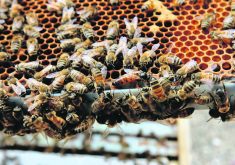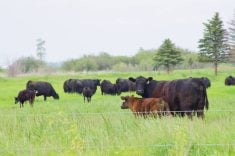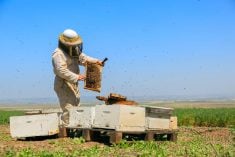Last year’s drought is a likely suspect in Manitoba’s high honeybee losses, and for multiple reasons, apiary experts say.
Ian Steppler, chair of the Manitoba Beekeepers’ Association (MBA), says diagnostics are ongoing, but conditions last year — which saw little rain until mid- to late summer, followed by abnormal growth and blooming in fall — may have created a compounding recipe of hive stress, friendly conditions for pests, as well as putting hives off their natural rhythm.
Early hive loss reports are commonly ranging between 30 and 50 per cent, with some as high as 70 or even 90 per cent losses, according to the beekeeping sector.
By mid-July last year, producers, including beekeepers, were describing their situation with words like “desperate.” Pastures were brown. Nectar sources had largely dried up. Honey flow had been limited, and was drying up early. Added to that, smoke from wildfires had blanketed Manitoba for stretches at a time, further stressing the bees.
Read Also

Manitoba farmers uneasy on expropriation
Farmland expropriation for Oak Bluff highway project brings process, farmer compensation concerns back to the fore.
Experts, such as provincial apiarist Rhéal Lafrenière, expressed worry at the time that brood production might shut down before hives could produce enough winter bees (the longer-lived bees that would take the hive through the cold months).
“Last year’s drought, the heat, the dryness, the smoke, it put a lot of stress onto our colonies and the thinking is that it maybe put them out of cycle a little bit and stressed them,” Steppler said. “It allowed, maybe, the pest cycle to take foothold and add enough stress through this cold, long winter that it maybe took them out.”
Blessing or bane?
When the taps turned on in August, however, beekeepers were suddenly facing a very different, and very abnormal, season.
Plants suddenly began to bloom, long past their typical season. In the hives, brood production kicked back into high gear.
That, Lafrenière suggested, might actually be part of the problem.
Bees typically don’t spend so long in maximum brood production as they did last year, he said, and with those higher bee numbers, mite populations also had a chance to grow.
“Us carrying larger populations into the fall, longer into the fall, is probably some of the reasons why we’re dealing with some high losses,” he said. “That’s if varroa was your dominant problem.”
Parastic varroa mites — known for weakening bees, making them more vulnerable to stress and carrying disease — were a serious problem for beekeepers last year.
Producers noted much higher-than-normal mite counts, leading to questions around resistance and major control products, since those products seem to be letting mites slip through.
Circumstances, however, also may not have set control measures up for success.
Mite counts and mite control typically happens after honey flow, Lafrenière said.
In a typical year, brood production would have also slowed when producers are dealing with mites. Last year’s second wind, however, likely meant that there was still “lots of brood in the hive,” and mites were still in the reproductive phase.
Bees are infested by varroa mites while still in the brood, since the mite lays eggs within the same cell as a bee larva.
That late brood, combined by the altered bee cycle at the time of sampling, means producers may have underestimated how much trouble they were really in, according to Lafrenière.
“If you just use the calendar when you take a mite sample at the end of September, when it tells you you’re one per cent or half a per cent (infested), you’re very happy, because there’s hardly any brood in the hive at the end of September in a normal year, so those are all the mites, (those) that are exposed to sampling. You would have fairly good control.
“If you got half a per cent or one per cent in a hive that is full of brood, that (mite) number is actually higher than that, because those mites are still reproducing in the brood and you’ve got to wait a couple more weeks until that brood really starts to wind down to really see what your mite population is.”
Infestation in winter bees is another possible problem, he noted. In a typical year, he said, mites would be controlled by the time hives are switching over to the longer-lived insects.
Outside of varroa mite stress, the provincial apiarist also noted reports of feed problems in some hives.
He also expects to see nosema disease or viruses spread by varroa mites (like deformed wing virus), which typically express themselves in times of stress.
“You could actually control those mites, but then there’s this lag effect of the viruses still putting stress on those bees,” he said. “There are so many reasons that the bees would have found this winter a challenge.”
















